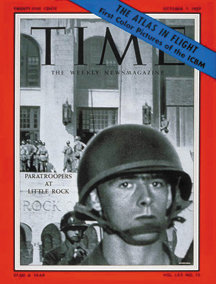William Patrick Cofield, known locally as “Billy,” loves to tell stories. Well known for his exaggerations, Billy once – over a friendly drink at a local bar – boasted about his father, Robert Patrick Cofield, being on cover of “Time” magazine.
“A man down the bar said only one man in Bayonne has even appeared on the cover of Time,” said Billy’s close friend, Michael Mulcahy.
Billy wasn’t telling tall tales. His father’s face appeared on the cover of the Oct. 7, 1957 edition of “Time” magazine, but his name was not mentioned.
A member of the 101st Airborne, Robert was among the soldiers that had been assigned to protect nine African American students who were entering a previously all-white school in Little Rock Arkansas in September, 1957.
“He was just a face in the crowd.” – William “Billy” Cofield
________
A week after the appearance of the photo, Gene Scanlon wrote a letter to “Time” to identify the soldier.
“We in Bayonne were surprised and proud to see one of our boys on the cover of ‘Time’ on Oct. 7,” Scanlon wrote. “You called him a paratrooper; to us, he is Pfc. Robert Patrick Cofield, 19, Company B, 327th Infantry, 101st Airborne. Pat volunteered for the paratroops a year ago to show that he was as good as his older brother Mike, who used to be a paratrooper with the Sand Airborne. He is a quiet, friendly, easy going guy, popular in his neighborhood. Since he has joined the immortals that made ‘Time,’ I thought you might like to know who he is.”
Robert, in volunteering for duty, stepped into history and into a national battle on the side of Dr. Martin Luther King Jr. and others who were seeking to change racist laws then in existence throughout many states in the deep South.
The move to seat the nine children in public school came after a U.S. Supreme Court ruling in 1954, which said schools were “inherently unequal.” So in September 1957, nine African American students enrolled at Central High School in Little Rock. The ensuing struggle between segregationists and integrationists, the State of Arkansas and the federal government, President Dwight D. Eisenhower and Arkansas Governor Orval Faubus, has become known in modern American history as the “Little Rock Crisis.” The crisis gained worldwide attention.
After a receiving a letter from Dr. King, President Eisenhower ordered the 101st Airborne Division into Little Rock to ensure the safety of the “Little Rock Nine,” and the rulings of the Supreme Court were upheld.
King told the president that if the federal government did not take a stand against the injustice, it would set the process of integration back 50 years.
“This is a great opportunity for you and the federal government to back up the longings and aspirations of millions of peoples of good will and make law and order a reality,” Dr. King said. He then later praised the president’s actions: “I wish to express my sincere support for the stand you have taken to restore law and order in Little Rock, Arkansas. . . You should know that the overwhelming majority of southerners, Negro and white, stand firmly behind your resolute action.”
Robert – who died in 2002 – never talked to Billy about the events from 1957, although that does not stop Billy from being proud of his father.
Robert, often called “Jeep” for his work at a mechanic at Harrington Service Station on Kennedy Boulevard in Bayonne, also worked at Bergen Point Brass.
“He was born and raised in Bayonne,” Billy said. “He graduated from Bayonne High School.”
